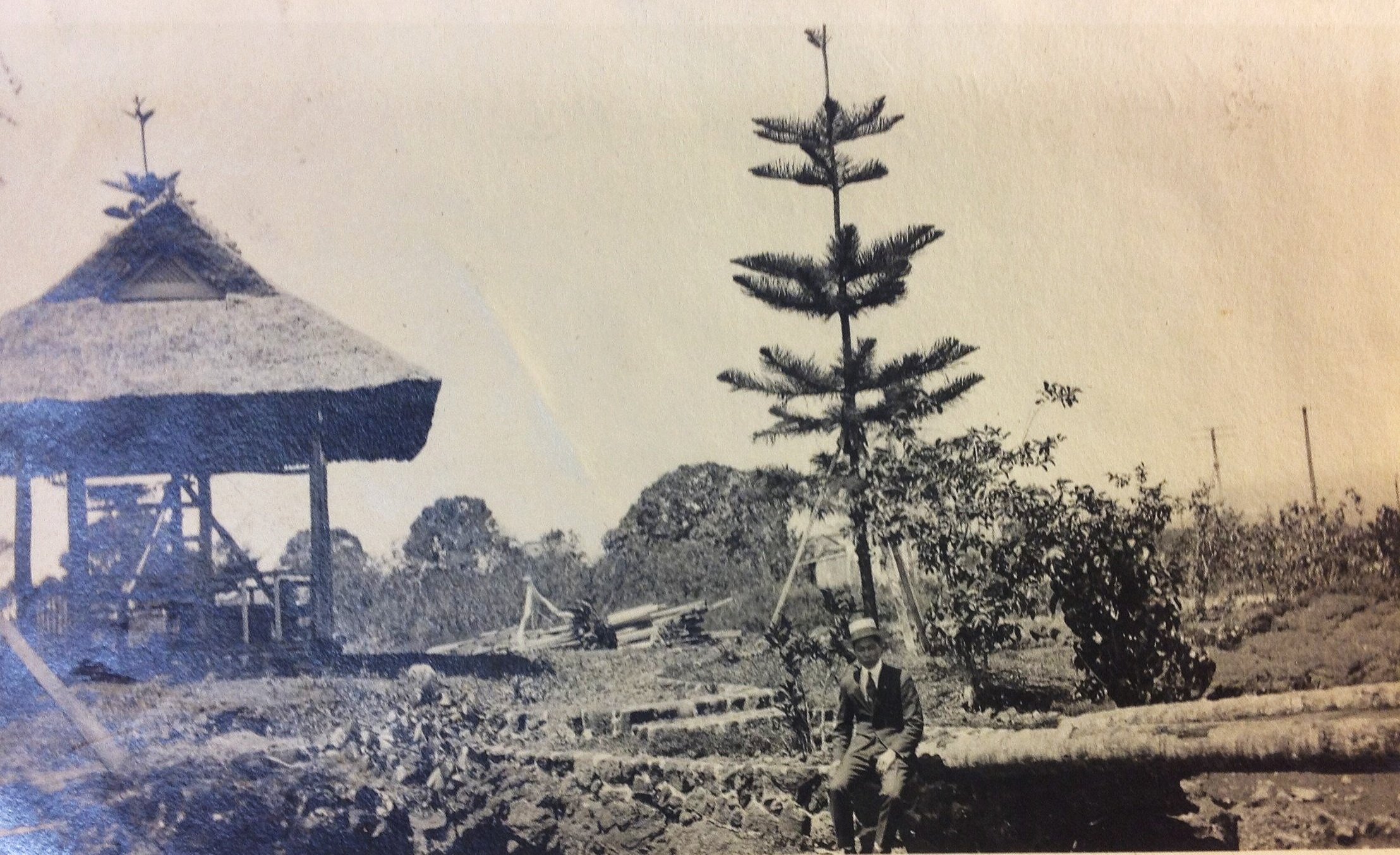
Garden Designers
Many hands have helped to make Liliʻuokalani Gardens what it is today.
Y.K. Yamamoto Original Garden Designer
Y.K. Yamamoto (per house records of Bide A Wee or J. Yamamoto? Or A.T. Yamamoto? from other sources), was the original designer of the gardens, from Kyoto (or Hilo). Search of passenger lists at the Hawaii State Archives and online has failed to turn up this name. Inquiries have been made of garden research institutes in Japan and of garden historians in the U.S. Still searching through old records in Hilo Public Library. A newspaper article in 1968 mentions a protégé of Yamamoto, Tiri Saiki, who worked to complete the design in Hilo. The above image may be of Y.K. Yamamoto sitting in what is now Liliʻuokalani Gardens.
1930s: Kiyoshi Takano Nakamura
Kiyoshi Takano Nakamura (known as Kiyoshi Takano) was born in Yamaguchi. He served a 15 year apprenticeship in Tokyo and Kyoto. He came to Honolulu (1902?) at the age of 28 and specialized in Japanese garden landscape. He was hired to add to Lili`uokalani Gardens with bridges and a tea house at the request of the board of park commissioners: Herbert Shipman, chairman. Members of the Hilo Woman's Club were involved in the expansion raising funds for a tea garden and granite pagoda. Mr. Nakamura was active in Honolulu in bonsai and ikebana, speaking often at the Honolulu Academy of Arts. He died in 1951.
The business was continued by his son Saishi "Pete" Takano Nakamura who greatly expanded the business. Pete worked with Kenzo Ogata on the Pagoda Hotel gardens and koi pond. He was a master of creating stone from concrete so the lighter "stone" could be used in rooftop gardens. Pete died in 1989.
Grandson Danny runs the company now.
[above information from newspapers.com Honolulu Star-Bulletin]
1950s: Nagao Sakurai
Nagao Sakurai of Tokyo, graduate from the Imperial University of Japan, Sakurai was Chief Gardener at the Imperial Palace in Tokyo for 20 years; Sakurai’s projects include the Japanese Tea Garden in Central Park, San Mateo; the Zen Garden in Golden Gate Park, San Francisco; the Japanese Rock Garden, Micke Grove Regional Park, Lodi; and the Nishinomiya Japanese Garden, Manito Park, Spokane, Washington.; at Lili`uokalani Gardens he was involved with the 1949 restoration (after 1946 tidal wave), and dry garden design near the park caretaker’s cottage (Mr. Obana). An interview with him including some information on Lili`uokalani Gardens appeared in a 1954 newspaper article in the Honolulu Star-Bulletin.
[above information from The Cultural Landscape Foundation]
[NOTE: Nagao Sakurai and Kazuo Nakamura were both involved with the Hannah Carter Japanese Garden in Bel Air, California]
1960s: Kinsaku Nakane
Kinsaku Nakane (1917-1994) firm in Kyoto, 1968 restoration after 1960 tsunami: Nakane created the lantern plan, while actual placement was accomplished by Patrick Oka of Honolulu. At this time one tori (gate) was placed, a gift of Oshima Island (Sister Island to Hawai`i Island); lanterns from prefectures where immigrants originated; guardian dogs/lions from Nagasaki; lanterns and other items were transported by three Japanese training ships and delivered in 1967.
The Nakane Garden Research & landscape Consultant Company is still in business.
1960s and 70s: Kazuo Nakamura
Kazuo Nakamura, 1964 rebuilding of Lili`uokalani Gardens, 1976 Bicentennial Garden within Lili`uokalani Gardens, and the nearby Rakuen Park (aka "Happiness Park") behind Suisan fish market; his name also appears as Engyo Nakamura in some publications and as Kazu on the plaque at Rakuen. Nakamura came from Kyoto to California then retired to Oahu then to Hilo.
Additional information from newspapers.com indicates that Mr. Nakamura first came to Hilo at the request of Laura Kennedy in the 1960s.
Kazuo Nakamura: garden around Shoroan tea house dedicated August 3, 1972 [NOTE: name Katsuaki Nobukuni also appeared in this connection.]
1990s: Fred Nonaka and David Tamura
Fred Nonaka of Kamuela and David Tamura of Hilo, with Isemoto Contracting implemented the garden around the new 1994 tea house.
2000s: Leonard Bissel
Leonard Bissel of Hilo, 2000 bond issue work; ADA compliant paths, tree trimming, new benches, new plantings, new gates.
2010s and 20s: David Tamura
David Tamura of Hilo: Volunteered with Friends of Lili`uokalani Gardens to create a master plan for the gardens, to break suggestions into separate projects, and to obtain costs for each; active in cleanup and pruning projects; helped Lions Clubs create a design for the stone setting at the southern corner of the gardens as their Legacy Project and organized contractors to provide equipment and labor for that project (2017-2018); organized contractors and equipment for the restoration of the suhama in 2022.
2010s: Takuhiro Yamada
Takuhiro Yamada of Hanatoyo Landscape in Kyoto started coming to Hilo Thanksgiving 2014. He returned several times to help get Shoroan ready for the 45th anniversary of Urasenke and the 20th anniversary of Shoroan in 2017 including planting a black pine tree. He advised on design and supervised installation with David Tamura and Fred Nonaka of the Lions Legacy Project in 2017-2018. He cared for black pine trees on several visits. He reset the stone pathway at the back of the tea house building. He tended to the tsukubai setting, placement of drain stones, and height of the bamboo water spout.
2020s: Hiromu Terashita
Hiromu Terashita master stone setter and a team of professional landscapers from Tokyo came in June 2022 to restore the suhama. The smooth stone beach restoration was funded by MLIT, a Japanese government program to send professionals to assist with gardens outside of Japan. Funding also was obtained from Historic Hawaii Foundation. Working with the Japan team were Fred Nonaka, David Tamura, Myles Nonaka, Andrew.
